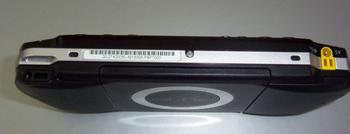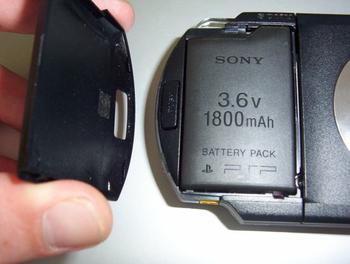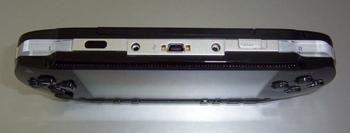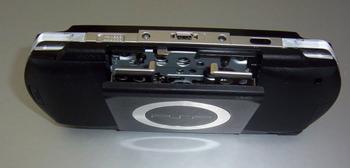More features than a 12 screen cinema
Either side of the screen are the two built in speakers which give good stereo sound but are very, very tinny. To be honest, I’d not expect anything else from such tiny speakers, but don’t let that fool you into thinking the PSP lacks some bass grunt. Using either a set of headphones with a mini stereo jack or the supplied ‘in the ear’ phones with inline remote, hook yourself up to hear the PSPs sound transformed. Playing ridge Racer becomes a whole new experience as you can hear jets roaring overhead, the throaty rumble of the car creeping up on the inside and so much more. Music wise, the bass is superb and only has the merest hint of distortion at full volume on my Sennheisers, but full blast is very loud, so I’ll doubt anyone other than the hearing impaired will want to play at that volume. Headphone and remote connector on the far left, DC charger socket on the right
Headphone and remote connector on the far left, DC charger socket on the right The battery… it provides power…erm… what else did you expect?
The battery… it provides power…erm… what else did you expect?On the other end of the unit is the 5v DC charging connection, through which you pump juice into the 3.6V 1800mAh battery pack. It takes a few charges to get the battery seasoned up properly but I reckon this one is giving between 4-5hours play on full screen brightness. Obviously, the more you do with the PSP, the quicker it drains the battery, so WIFI gaming will be a shorter experience than solo play.
 The Memory Stick slots in under this little rubber hinged flap
The Memory Stick slots in under this little rubber hinged flapUnderneath the left hand side is the slot for the memory stick, Sony’s proprietary memory card. The PSP will come bundled with a 32MB version but Sony are going to be producing a 1GB stick which should give you plenty of room for music, videos and photos. With modern compression techniques, you’ll easily be able to get a full movie onto the stick and still have a perfectly watchable resolution.
Access to the PSP’s memory stick is either through a card reader or mini-USB, a socket for which is located on the top of the unit. Unfortunately, there’s no cable supplied but you’ve more than likely got one hanging around if you’ve got something like a digital camera as well.
 Here you can see the two shoulder buttons, the IR port, USB port and UMD slot catch
Here you can see the two shoulder buttons, the IR port, USB port and UMD slot catchSadly, sticking music and movies onto the PSP isn’t as simple as just dragging and dropping as the PSP uses its own playback codec. Luckily, there’s no shortage of converters freely and legally available on the web, with one being able to convert pretty much anything on your PC provided you have the codec to view it installed. Music can be dragged across in MP3 format but you’ll have to create a directory structure the PSP can understand, which is a pain to first time out abut a doddle afterwards as you’ve done the hard work. I would strongly suspect Sony to be releasing some form of docking software fairly soon to make the process far easier for the less technical minded amongst us.
Core to the PSP is the UMD disc slot. A small slider catch on the top of the PSP pops open the door mounted on the rear and up pings the UMD. The disk itself is slightly smaller than a standard mini-disk and the housing has been rounded off considerably to reduce the cartridge’s overall size. Capacity is not diminished though with top games and several full movies already available.
 And here’s the UMD slot opened up
And here’s the UMD slot opened up

